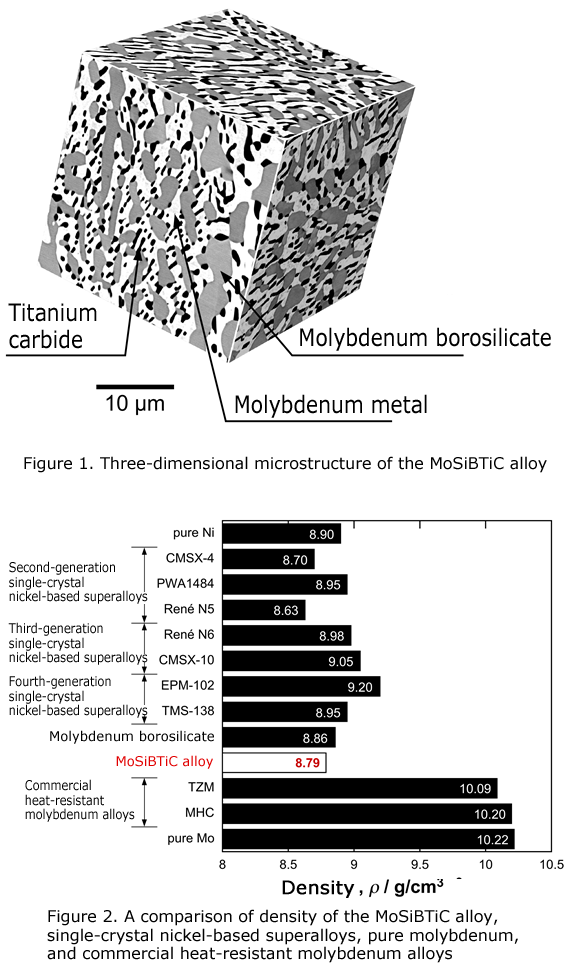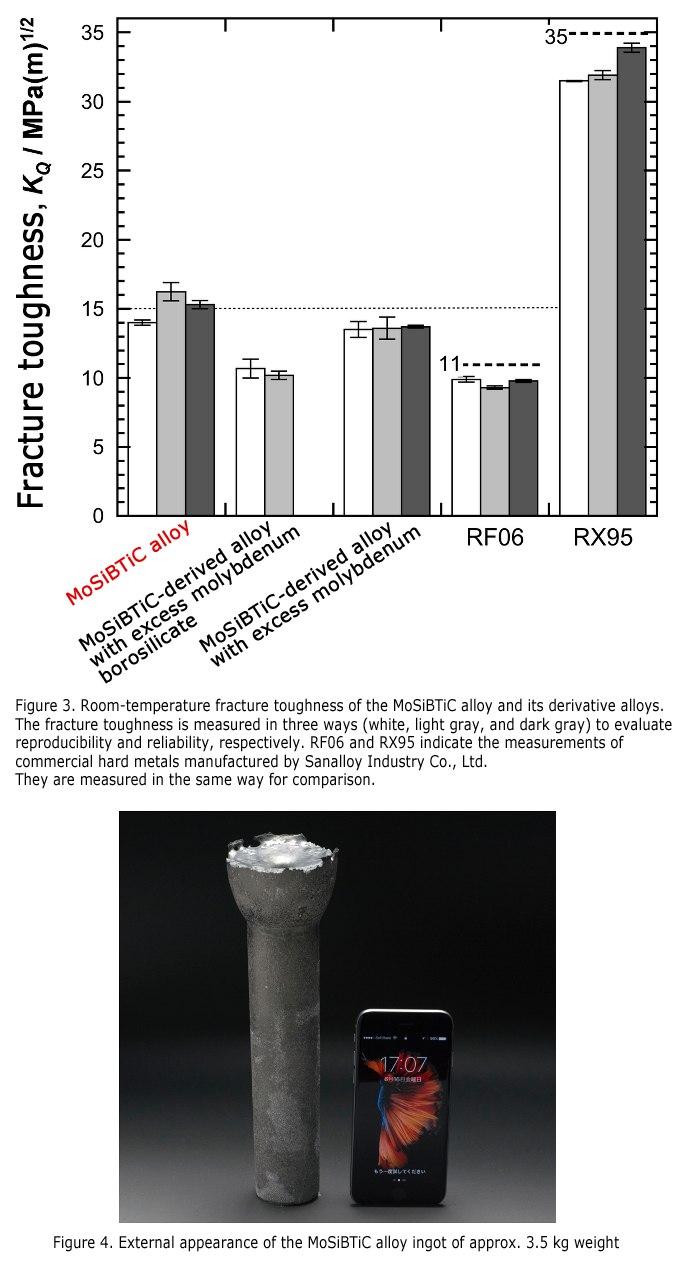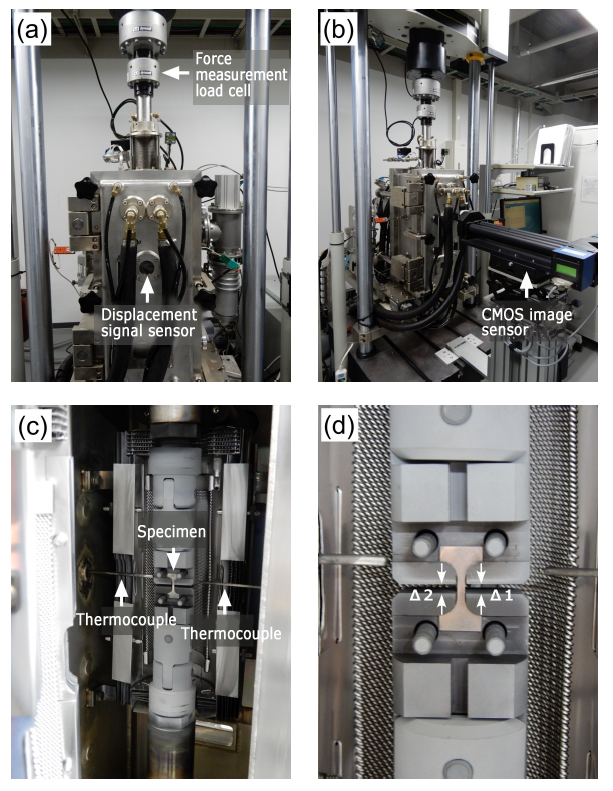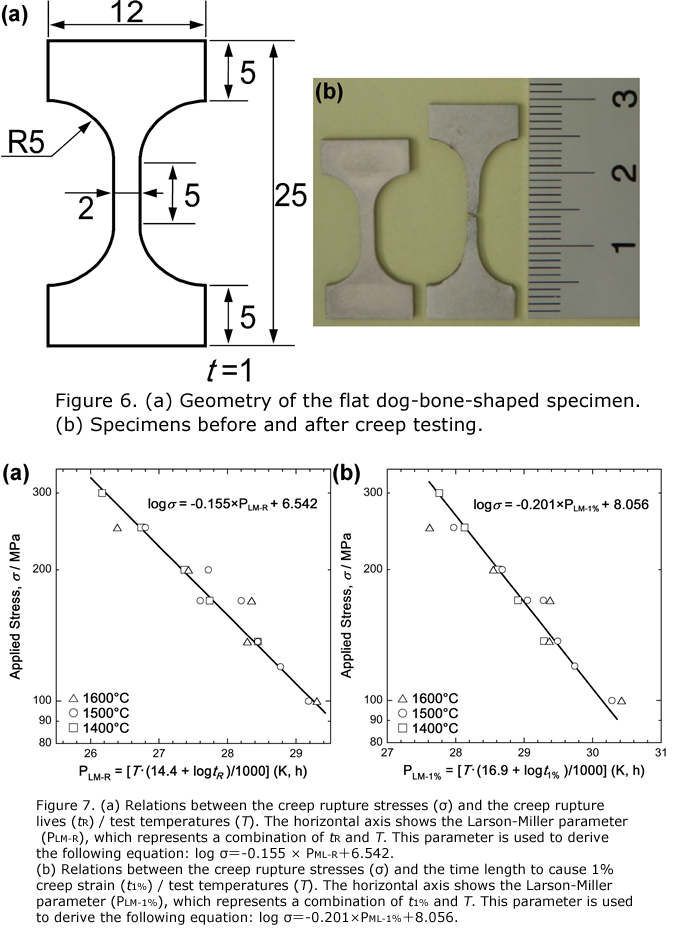[Overview]
A joint research group consisting of Kyosuke Yoshimi, Professor of the Department of Materials Science, and Yutaka Sato, Professor of the Department of Materials Processing, both at the Graduate School of Engineering, Tohoku University, has developed a new heat-resistant molybdenum alloy (MoSiBTiC alloy) with excellent fracture toughness as well as superior strength in the temperature range from room to ultra-high temperatures. They have also succeeded in precisely measuring the strength of the alloy in the temperature range of 1400–1600°C.
The high-temperature, high-pressure rotating parts of jet engines and power generating gas turbines are generally made of nickel-based superalloys. In order to further increase the energy efficiency of these heat engines, research efforts have continued to develop new heat-resistant materials, or so-called ultra-high temperature materials. Meanwhile, because materials of high strength at high temperatures are generally fragile and prone to fracture, extensive efforts have also been directed at overcoming this disadvantage to achieve commercialization.
This study has developed a new alloy by combining molybdenum, a refractory metal, with certain concentrations of titanium, silicon, carbon, and boron. This alloy can be used to produce relatively large and representative specimens by the melt casting process in a laboratory. At room temperatures, it has a fracture resistance equivalent to that of commercial hard metals. These properties allow the preparation of samples of adequate size and the precise measurements of strength of the alloy in the ultra-high temperature range of over 1400°C. Based on these measurements, the heat resistance temperature of this alloy is estimated to be 200°C higher than that of nickel-based superalloys.
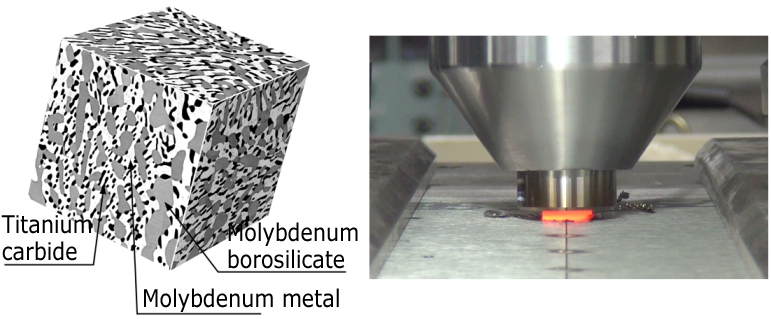
(Left) Microstructure of the heat-resistant molybdenum alloy developed in this study
(Right) Friction stir welding of Inconel alloy 600 using a friction stir welding tool made of the molybdenum alloy
Moreover, we have demonstrated the superior heat resistance of this alloy by using a friction stir welding tool made of this alloy for the friction stir welding (Note 1) of Inconel alloy 600. As shown in this demonstration, the alloy developed in this study is highly likely to contribute to improving the efficiency and reliability of heat engines as well as increasing the operating temperature and precision of metal working machines.
A part of this study was published online in the British scientific journal "Scientific Reports" at 6 pm, July 11, 2018 (Japan Standard Time).
[Details]
1. Background
The development of lightweight, high-temperature materials for fossil-fueled heat engines is the key to increasing the efficiency of heat engines and promoting fuel conservation and stable electricity supply. The high-temperature, high-pressure rotating parts of jet engines and power generating gas turbines are made of nickel-based superalloys, mainly composed of nickel, chrome, cobalt, and aluminum. Over nearly 80 years of research and development from the 1940s to analyze alloy composition and metal working processes to enhance heat resistance, it is said that the upper temperature limit of heat engines is now approaching 1150°C.
Meanwhile, the operating temperature of state-of-the-art jet engines is approaching 1700°C. In order to fill the gap between the heat-resistance temperature of nickel-based superalloys and the operating temperature of jet engines, extensive efforts have been made to develop cooling and coating technologies. However, as J. H. Perepezko, Professor of the University of Wisconsin in the US, pointed it out in the American scientific journal “Science” in 2009, the cooling process could cause a significant energy loss. A fundamental solution to this problem requires the development of new heat-resistant materials, or so-called ultra-high temperature materials, with a higher heat resistance than nickel-based superalloys, to bring the heat-resistance temperature of raw materials up to the operating temperature of jet engines to reduce the gap between them.
Although various high-temperature materials have been proposed so far, their applications to high-temperature, high-pressure rotating parts of heat engines have been unsuccessful due to some materials engineering or technical problems. Needless to say, high-temperature materials should have a high heat resistance, which is defined as creep strength (Note 2). Another important challenge is how to enhance resistance to fracture and fatigue. As indicated by Dr. K. Lu, Chinese Academy of Sciences, in its journal “Science,” there is a trade-off relation between strength and fracture toughness; strong materials are less fracture resistant, and fracture-resistant materials are less strong. Therefore, the development of strong and fracture-resistant materials has remained as a major challenge. Moreover, advanced technologies are required to process strong and refractory materials like nickel-based superalloys. Although the metal powder sintering process is relatively easy to handle, because this technique has many problems, such as vulnerability to contamination, difficulties in molding large parts, and strength degradation at higher temperatures, the melt casting process has been considered suitable for ultra-high temperature materials. However, it is also confronted with technical barriers now that most molybdenum alloys are produced by the powder sintering method.
2. Achievements and Their Meanings
Our research group found that a TiC-reinforced Mo-Si-B-based alloy (also known as a MoSiBTiC alloy), produced by the melt casting process to add high concentrations of titanium and carbon to a globally spotlighted ternary alloy composed of molybdenum, silicon, and boron, has a density equivalent to that of a nickel-based superalloy (approx. 8.8 g/cm3) as well as exhibits superior strength at high temperatures. This finding was reported for the first time in 2014. Since molybdenum and a representative ternary alloy of molybdenum, silicon, and boron have a density of approximately 10.2 g/cm3 and 9.1 g/cm3, respectively, we attributed the weight reduction to titanium and carbon. Moreover, our research group reported in 2017 that this MoSiBTiC alloy has a room-temperature fracture toughness exceeding 15 MPa(m)1/2, which is the world’s highest value for Mo-Si-B-based alloys. Furthermore, we experimentally demonstrated that the melting point of this alloy is approximately 1920°C. We assumed that the melting point of molybdenum (approximately 2620°C) may drop markedly, depending on the composition ratio of titanium, silicon, carbon, and boron, and considered that this would make the melt casting process easier. In fact, we have demonstrated the capacity to produce a 3.5 kg large ingot.
These findings and developments made it possible to prepare a relatively large, representative specimen of a MoSiBTiC alloy. We therefore produced flat dog-bone-shaped tensile test specimens (Note 3) with a length of 25 mm, a width of 5 mm, and a thickness of 1 mm and systematically measured their creep properties (Note 2) in the ultra-high temperature range of 1400–1600°C. We determined the deformation rate of the specimens by measuring the gap between the specimen holder edges with a CMOS image sensor (Note 4). In this way, we could reduce measurement errors due to the deformation of the test device as much as possible and precisely measure creep properties while using the non-contact sensor. Based on the analysis of all creep data obtained in this study, the temperature to cause rupture in 1000 hours under a stress of 137 MPa is estimated at 1360°C, which is more than 200°C higher than for nickel-based superalloys. Moreover, the stress to cause 1% strain in 125 hours at 1200°C is estimated at 270 MPa, which shows that this MoSiBTiC alloy has a higher fracture toughness not only than nickel-based superalloys but also than the new niobium alloy developed by the U.S. General Electric. Thus, this study demonstrated the superior high-temperature creep properties of the MoSiBTiC alloy. In the future, when used as alternatives to nickel-based superalloys, MoSiBTiC alloys are highly likely to boost the efficiency and reliability of high-temperature, high-pressure rotating parts of heat engines and significantly improve the efficiency of energy conversion.
Another example of applications of ultra-high temperature properties of MoSiBTiC alloys was a friction stir welding tool made of a MoSiBTiC alloy. By using this tool, we have succeeded in the friction stir welding of Inconel 600®, a heat-resistant nickel alloy (recorded in video). Although several materials, such as tungsten alloys and hard metals, have so far been proposed as high-strength materials for friction stir welding tools, none of them have been really successful because their strength would degrade with temperature increasing due to working heat and other reasons. Therefore, it was meaningful that this study demonstrated the superior heat-resistant properties of MoSiBTiC alloys. In light of the above, we consider that the development of this alloy is highly likely to contribute to improving the efficiency and reliability of heat engines as well as increasing the operating temperature and precision of metal working machines.
3. Future Plans
This study demonstrated that the MoSiBTiC alloy, produced by the melt casting process with a balanced combination of molybdenum, titanium, silicon, carbon, and boron, has superior heat resistance and fracture toughness. Given the development timeline of heat engines, it will take a while to replace existing high-temperature, high-pressure rotating parts of jet engines and gas turbines with those made of the MoSiBTiC alloy. Still, it is expected to take a step-by-step approach towards this end by improving reliability and manufacturing technology while accumulating applications to friction stir welding tools and hot working dies. This process will be further promoting research and development to advance metal working technology while enhancing the MoSiBTiC alloy’s oxidation resistance, coating technology, and other functions.
[Publication Information]
Shiho Yamamoto Kamata, Daiki Kanekon, Yuanyuan Lu, Nobuaki Sekido, Kouichi Maruyama, Gunther Eggeler & Kyosuke Yoshimi, "Ultrahigh-temperature tensile creep of TiC-reinforced Mo-Si-B-based alloy", Scientific Reports, 2018.
DOI: 10.1038/s41598-018-28379-w
This study is a part of the study project, Advanced Design and Casting Process Development of MoSiB-Based Ultra-High Temperature Materials (No. JPMJAL1303), supported by Japan Science and Technology Agency (JST) through one of its Strategic Basic Research Programs: Advanced Low Carbon Technology Research and Development Program (ALCA).
[Glossary]
Note 1. Friction stir welding
This is a technique to join workpieces in a solid state, without melting them, by plunging a rapidly rotating tool into them and stirring while softening them with frictional heat.
Note 2. Creep strength / creep property
Creep (deformation) is a deformation mechanism at high temperatures. Creep strength (creep property) is defined as resistance to creep deformation. At low temperatures, the creep stress is so small that only strain deformation is observed; however, at high temperatures, plastic deformation occurs over time while permanent strains are gradually accumulating.
Note 3. Dog-bone-shaped specimen
It is a tensile test specimen named after a bone-shaped dog toy because of its shape.
Note 4. CMOS image sensor
CMOS stands for Complementary Metal Oxide Semiconductor. This semiconductor works as a light receiving element for CMOS image sensors, used as an image sensor for digital cameras and scanners. This sensor turns light into electric signals. In general, this sensor works at a lower voltage than a CCD sensor and allows high speed reading.

